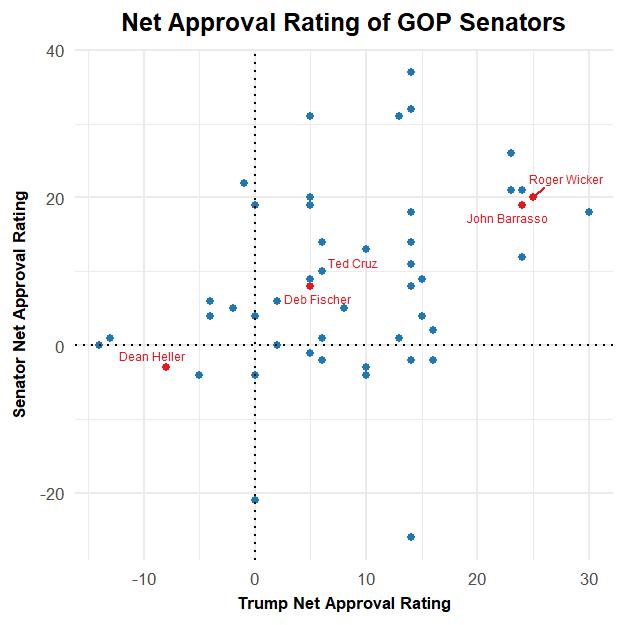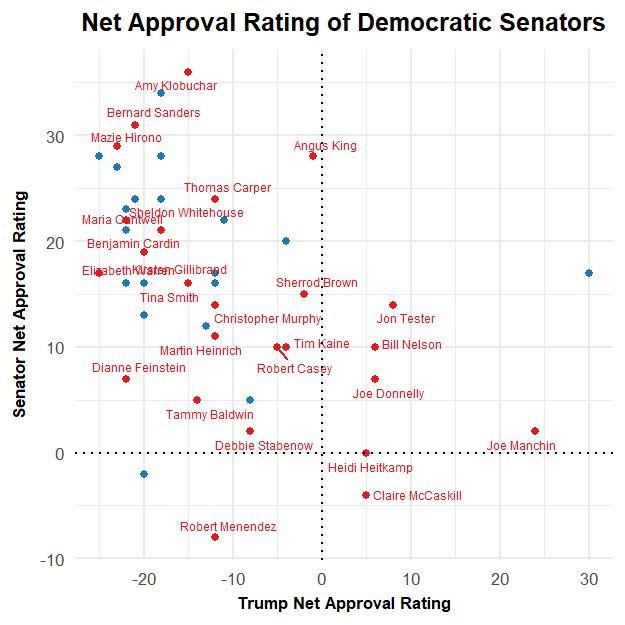Every quarter, Morning Consult produces one of my favorite polls: a 50-state survey that measures the approval rating of every sitting senator. This poll allows us to get data on every senator simultaneously and from the same pollster. There are obviously hazards to looking at just one poll (even the best pollsters can get wonky samples), but this mega-poll style lets us do some interesting apples-to-apples comparisons between senators.
You can do a lot with these data, but I focused on sitting senators who are running for re-election in 2018. Specifically, I paired these data with another data set from Morning Consult and got a sense for which incumbents are (and aren’t) popular at home, how those numbers look in context of Trump’s state-by-state numbers, and what it all means for the midterms.
The Republicans: Low Exposure and Tough Times for Dean Heller

This graphic shows the net approval rating for each senator (approve/disapprove) on the vertical axis and Trump’s net approval on the horizontal axis. Each point is a Republican senator, and the senators who are running for re-election are labeled and shown in red (the rest are blue). The dotted lines are zero lines: They show you where Trump is or isn’t above water and which senators are or aren’t above water.
The basic message of this graphic is clear: There aren’t many Republican incumbents, but the ones who aren’t named Dean Heller seem to be doing well. Deb Fischer of Nebraska, John Barrasso of Wyoming, and Roger Wicker of Mississippi all look solid for their re-election. Ted Cruz could still lose his race, but SwingSeat (THE WEEKLY STANDARD’S Senate Forecast Model) projects that he has a roughly four-to-one chance of being re-elected.
The big exception to this rule is Dean Heller. Heller, the Republican senator from Nevada, has been running slightly behind Democrat Jacky Rosen in our projections. Heller is fighting an uphill battle: Nevada voted for Hillary Clinton once and Barack Obama twice, and the national political mood favors Democrats. This poll, which shows Heller with a 37-percent approval rating, is another piece of negative news for him.
The Democrats: High Exposure with Mixed News
We can generate the same graphic for the Democrats and take it quadrant by quadrant:

The upper-left-hand corner is the Democratic “safe zone.” The points there represent senators who have a positive net approval rating and represent states where President Trump has a net negative approval rating, according to Morning Consult. That section of the graphic is (relatively) densely populated. That’s because about half of the Senate Democratic Caucus (I’m counting Bernie Sanders and Angus King as Democrats, here) are running for re-election this cycle, and most of them are running in blue states.
The upper-right-hand section can be thought of as the “red state, blue senator” area. Montana senator Jon Tester, West Virginia senator Joe Manchin, Florida senator Bill Nelson, and Indiana senator Joe Donnelly all sit in that segment (and Heidi Heitkamp straddles the division). Some of these senators are running better than others (e.g., SwingSeat thinks Republican Mike Braun is a slight favorite against Donnelly, but it thinks Manchin has a significant advantage over Republican Patrick Morrisey), but all of them are either still in the game or leading despite Trump having won their state in 2016.
Claire McCaskill occupies a similar zone to Heller: Trump’s approval rating is positive in Missouri, according to Morning Consult, and her net approval rating is negative. That makes sense, intuitively.
McCaskill represents a red state, but in the past she’s run about as well as you’d expect a replacement-level Democrat to run. Put simply, she may not have the political skill or personal brand of a Heitkamp or a Manchin, and that could lead to negative ratings in a red state. That doesn’t mean that McCaskill will lose (SwingSeat thinks the race is very close), but it helps explain the results of this poll.
Finally, Bob Menendez of New Jersey sits in the lower-left-hand corner. I call it the “Menendez-Flake-McConnell” zone because all have lower approval ratings than a replacement-level senator from the same party (e.g., Cory Booker in New Jersey) likely would. But Menendez has a history of ethical issues. He was indicted for fraud and bribery, and was officially admonished by the Senate Ethics Committee (though a federal judge dismissed the charges).
Voters seem to be unhappy about that. Menendez earned a strong negative rating in this poll and has had some trouble in recent horse-race polls. Maybe most significantly, there was a real protest vote against him in his primary. He’ll likely win re-election anyway (New Jersey is a very blue state), but the lower-left-hand corner of this graphic is not a particularly fun place to be.
Overall, these approval numbers emphasize a few key points about the upcoming Senate elections: Republicans have very little exposure. Democrats have a lot of exposure, but are mostly running solid candidates in Trump-ier states. And if Bob Menendez lived in a different state, he might be in a lot of trouble.
